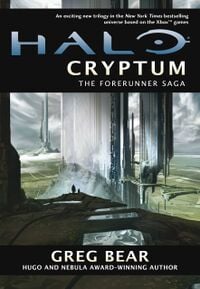The Forerunner Saga
From Halopedia, the Halo wiki

The Forerunner Saga is a series of Halo novels focusing on Forerunner life 100,000 years before the Human-Covenant War, being written by Greg Bear and published by Tor Books.[1] The first novel, titled Halo: Cryptum, was released on January 4, 2011.[2] The second novel in the trilogy, titled Halo: Primordium, is set to be released in 2012.[3]
Background
- "A science fiction icon and winner of the field’s highest awards, Greg Bear has signed on to write three Halo novels set in the time of the Forerunners, the creators and builders of the Halos. Almost nothing is known for sure about this ancient race. Worshiped by the Covenant as gods, their engineering relics pepper the galaxy, and their connections to humanity remains unanswered. Devoted fans of both the books and games will finally get to delve deep into the era of these enigmatic beings, and discover for themselves the epic story behind one of the great mysteries of the Halo universe: the complete disappearance of the Forerunners from existence. World publication rights to Tor Books."
- — Tor Books
- "It's going to be a trilogy. A connected universe that will remain faithful to the scale and mysteries, while exploring the detail and challenges of a VERY powerful culture. This won't be some skirt-raising exercise in Forerunner populist-ism. Folks know way more about Forerunners than you think, but we're definitely going to respect that strange sense of wonder and awe that Bungie infused from day one. It will be BIG Greg Bear fiction in a faintly familiar place, but one that's full of surprises. Think Eon."
- — Frank O'Connor
Originally known only as the "Forerunner Trilogy", the series was officially announced at the Emerald City ComiCon in Seattle, Washington, where its author, Greg Bear, made a guest appearance.[4] The first book's working title was "Antediluvian".[5] The word "antediluvian" means, "of or belonging to the period before a flood," hinting that the novel takes place prior to the Forerunner-Flood War. The series reveals a great deal of new information about the Forerunner-human interactions in ancient history.[6][7] On October 11, 2010, the official name of the book was revealed to be Halo: Cryptum.[8]
During the writing process artists such as Sparth of 343 Industries created several illustrations for Halo: Cryptum. Frank O'Connor has mentioned that these illustrations will eventually be released in an art book.[9]
Synopsis
Set during the golden age of the Forerunners, the series will touch on the origins of humanity and the contacts with Forerunners and humans, as well as explaining the connection between the two and humanity's status as "Reclaimers". Forerunner technologies are explored in detail, and many new elements about the Forerunners are introduced, such as their political system and social structure. The characters of the Didact and the Librarian, introduced in the Terminals, are featured as central characters in the series.[10][6]
Cryptum
- Main article: Halo: Cryptum
Released January 4, 2011,[11][2] Cryptum focuses on a young Forerunner known as Bornstellar Makes Eternal Lasting, a rebellious Manipular from a family of Builders, the highest and most politically powerful rate of the Forerunner. However, instead of following in his father's footsteps and becoming a Builder, Bornstellar is obsessed with exploring artifacts left behind by the Precursors, an enigmatic galactic civilization that preceded the Forerunner. His father sends him to the planet Edom in a distant system known as Sol to work with the Miners, one of the lowest classes in Forerunner society, to come to terms with his duty as a Builder. Eventually, Bornstellar crosses paths with two humans on Earth, forever changing the fate of the galaxy.[12]
Primordium
- Main article: Halo: Primordium
Announced alongside the official press release of Halo: Glasslands, the sequel to Cryptum is to be released on January 3, 2012.[3] According to Greg Bear, Mendicant Bias will play a prominent role in the novel.[13]
Sources
- ^ HBO Forums: Greg Bear writing Halo novels about Forerunner
- ^ a b Halo Waypoint: Science fiction legend Greg Bear set to explore the time of the Forerunners
- ^ a b Halo Official Site: Tor Books reveals title, cover art of first Halo novel from #1 New York Times bestselling author Karen Traviss
- ^ EmeraldCity ComiCon 2009 schedule
- ^ YouTube.com — Emerald City ComiCon 2010
- ^ a b Tor.com — Halo: Cryptum chapter one excerpt
- ^ YouTube: SDCC: Halo Universe Panel Part 4
- ^ Joystiq: Halo: Cryptum novel by Greg Bear launching in Jan. 2011
- ^ Halo Waypoint: 'Greg Bear talks Halo: Cryptum
- ^ 343 Industries Podcast #1
- ^ Amazon.com: Untitled Forerunner Novel #1
- ^ Halo: Cryptum, forward jacket description
- ^ Greg Bear - Discussion Board - Halo Cryptum question